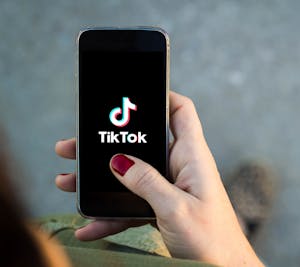- 6 minute read
- Digital Marketing
- Social Media
Want to add a clickable link in Instagram? Use a Link in Bio Tool
Intermediate
Get a behind-the-scenes-look into FareHarbor's 2024 season

If you’ve spent any time on social media lately, you’ve likely heard of or seen videos from TikTok. This relatively new social media platform, which has been popular with Gen Z users, is becoming more mainstream, and companies are turning to it to cultivate brand awareness – especially with younger audiences. If you haven’t heard of it before, TikTok is a social media application that debuted in 2018. It’s owned by Chinese firm ByteDance, which acquired the app Musical.ly in 2017 and eventually evolved it into the new app TikTok. This video-based application allows users to create, edit, and share short videos (15 to 60 seconds) using a vast library of music, effects, AR filters, and more.
According to Hootsuite –
Particularly amid the COVID-19 pandemic, many people turned to TikTok for entertainment, and the app is growing in popularity among millennials. TikTok videos can be easily shared on other platforms like Instagram and Twitter, which has helped its popularity grow.
@sandiegozoo We celebrated Zuli’s 1st bday yesterday for WorldElephantDay! 🎉 Enjoy this recap of his 1st year.
Not on TikTok yet? Check out our step-by-step guide to getting started with TikTok.
 While other social media platforms like Facebook and Instagram mainly show users content created by the people they have selected to follow, TikTok makes it easy for users to discover content based on their interests. The most used feed on TikTok is the For You feed – where the algorithm curates videos that it thinks users want to see based on their past usage of the app. This means that users are exposed to a variety of content whether they follow the creators or not, and it gives influencers and brands an opportunity to reach new audiences, have their posts go viral, and rack up thousands and up to millions of views and followers in a short timespan.
While other social media platforms like Facebook and Instagram mainly show users content created by the people they have selected to follow, TikTok makes it easy for users to discover content based on their interests. The most used feed on TikTok is the For You feed – where the algorithm curates videos that it thinks users want to see based on their past usage of the app. This means that users are exposed to a variety of content whether they follow the creators or not, and it gives influencers and brands an opportunity to reach new audiences, have their posts go viral, and rack up thousands and up to millions of views and followers in a short timespan.
As TikTok becomes more popular, brands are turning to the social media platform to experiment with video content and reach new users. Advertising is relatively new to the platform, and the current marketing value of the app lies in its capability to expand brand awareness rather than generate leads or conversions. By participating in challenges, sharing funny videos, and more, brands can reach a whole new demographic. This guide will cover TikTok’s main features, how marketers can use them to drive brand awareness, and examples of brands that are using the app successfully.
TikTok has a wide variety of features that allow users to make their videos more fun and viral-worthy. Features include visual effects, transitions, GIFs, stickers, green screens, split screens, and more. Here are some of the most popular features:
Hashtag challenges are a major part of what makes TikTok… well, tick. Many brands are capitalizing on this by creating viral challenges that can lead to great brand exposure. According to Hootsuite, 35% of TikTok users have participated in a challenge, and 16% of the content on the platform is linked to challenges. The basic idea is to challenge users to do something odd or difficult (such as the water cap bottle challenge, where people had to do a roundhouse kick and try to unscrew a water bottle cap by grazing it with their feet), do a specific dance, or some other activity with the potential to go viral.
Challenges are often started by users and can easily become widespread thanks to the For You page algorithm. Businesses have jumped on this trend to promote brand awareness through successful challenge campaigns. One way to ensure that challenges go viral is by working with influencers to promote your challenge.
For example, @gilmhercroes, who has more than 26 million TikTok followers, did a sponsored post for Chipotle’s #chipotlelidflip challenge that received millions of views and over 500,000 likes.
@gilmhercroes I Love @chipotle 🤩 I challenge you to try the #chipotlelidflip , can you do it?🤣 #ad
Even if you don’t have the budget or reach to have influencers promote your posts, hashtag challenges have the potential to spread organically, and they’re a great way to get user-generated content. After all, social media is all about interaction. While most traditional marketing channels are just a one-way conversation – with the company speaking to their audience – the appeal of social media is that it allows users to participate. TikTok users in particular are interested in reaching as many people as possible with their videos, and challenges provide an opportunity to do just that.
One brand that had huge success in eliciting user-generated content is the video game Fortnite, whose #EmoteRoyaleContest hashtag has already been used over 250 million times. Their campaign encourages users to create their own “emote” (a dance move or other physical expression that characters can do in the game) for the chance to have their creation be added to the game. This generated millions of submissions and is a perfect example of understanding your target audience.
@poki i can’t believe i’m saying this but i have my own @Fortnite Emote! 🤯🥳 you can get one too by entering a dance with #EmoteRoyalecontest #EpicPartner
With its visual and adventurous nature, the travel and tourism industry is a great fit for hashtag challenges. Think of creative ways to invite users to participate in a challenge – such as a cliff-diving challenge at a popular spot in Hawaii, an axe throwing challenge, a food challenge, and more. Remember that the majority of TikTok users Gen Zers, so keep the challenges safe, appropriate, lighthearted, and fun!
 Advertising is still quite new to TikTok, so brands are still experimenting with paid promotions. Some of the paid options are quite pricey — such as the banner ad at the top of the Discover page, which according to The Verge can cost hundreds of thousands of dollars – and is really only available to big-name brands with huge advertising budgets. Other options include takeover ads, which take up the full screen for 5 seconds, and in-feed video ads, which are essentially promoted posts 5 – 15 seconds in length and can have a more accessible price point. Until more affordable advertising options are available, the primary benefit TikTok offers to businesses is the ability to drive brand awareness, and have some fun while doing it!
Advertising is still quite new to TikTok, so brands are still experimenting with paid promotions. Some of the paid options are quite pricey — such as the banner ad at the top of the Discover page, which according to The Verge can cost hundreds of thousands of dollars – and is really only available to big-name brands with huge advertising budgets. Other options include takeover ads, which take up the full screen for 5 seconds, and in-feed video ads, which are essentially promoted posts 5 – 15 seconds in length and can have a more accessible price point. Until more affordable advertising options are available, the primary benefit TikTok offers to businesses is the ability to drive brand awareness, and have some fun while doing it!
We can’t talk about a social media platform without mentioning influencers – and influencers are made on TikTok more than on any other platform; this provides a wealth of opportunities for brands to partner with influencers to reach their target audiences. Influencers can popularize hashtag challenges, promote products, and more. The cost of engaging an influencer depends on the size of an influencer’s following and may be out of reach for many businesses, but working with up-and-comers is a great way to get some brand exposure without breaking the bank.
 TikTok is a fairly new platform, so there’s a lot to learn about how it can work for brands and what best practices should be used to market on the platform. However, it’s already proving to be an effective way for companies to reach large audiences and create brand awareness with fun and creative posts. If your target audience is on TikTok, it might be time to give it a try and start experimenting to find out how it can work for your business. You can learn about more platforms on our social media guides.
TikTok is a fairly new platform, so there’s a lot to learn about how it can work for brands and what best practices should be used to market on the platform. However, it’s already proving to be an effective way for companies to reach large audiences and create brand awareness with fun and creative posts. If your target audience is on TikTok, it might be time to give it a try and start experimenting to find out how it can work for your business. You can learn about more platforms on our social media guides.